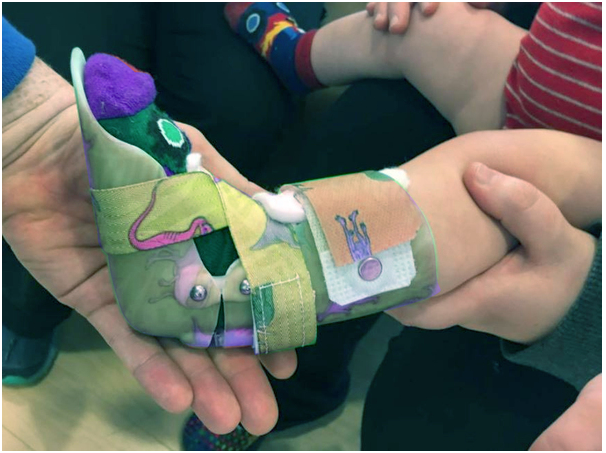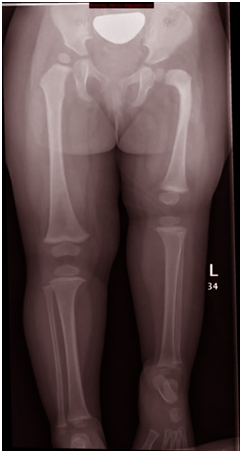Congenital Short Femur – All you need to know

Perthes Disease – All you need to know
May 21, 2021
Bone and Joint Infections in Children – All you Need to Know
May 21, 2021
A congenital short femur is a form of congenital malformation that affects the femur bone’s growth in the upper leg during prenatal development. The femur might be small or smaller than the other leg. This causes leg length differences, knee and hip instability, and several functional problems in a child. The child’s parents must visit an orthopedic doctor in Gurgaon for diagnosis and early treatment.
A multidisciplinary team is required for the assessment of congenital short femur. The team will prepare a personalized treatment plan to meet the child’s special needs. There is no single treatment that can work for all children. Treatment for congenital short femur varies based on the severity of the condition. It includes:
- Limb-lengthening procedures
- Prosthetics
- Surgery
The treatment aims to improve the functional use of the affected leg.
What are the causes of congenital short femur?
The cause of congenital short femur is unknown. Researchers believe that most forms of the congenital short femur are caused by a disorder during prenatal development. Such disorders during prenatal development might occur randomly or because of infection or trauma.

What are the symptoms of congenital short femur?
The main symptom of the congenital short femur is the presence of a shortened femur bone during birth. An affected femur bone may also be flexed, externally rotated, and abducted.
Congenital short femur causes instability in the knee and hip joint linking it to other disorders like fibular and ACL deficiency, flat feet, and clubfoot. The condition usually affects only one leg.
How is congenital short femur treated?
Congenital short femur treatment differs from child to child and is dependent on:
- The age of the child and his or her complete health and medical history
- The seriousness of the child’s condition
- The stability and condition of the child’s knee, hip, and foot.
To fix the child’s functional issues, a multidisciplinary team of pediatric orthopedic surgeons, prosthetists, and physical therapists will develop a personalized recovery plan that can include limb-lengthening procedures, prosthetics, and surgery.
The treatment aims to enhance the child’s overall function to move and grow at a rate comparable to their peers.
Treatment usually starts when the child turns three years old, which allows time for early bone hardening. The treatment ends at the end of high school when most children have stopped growing.
The procedures used for treating congenital short femur are explained in detail below.
Limb-lengthening
Most children with congenital short femur benefit from limb-lengthening procedures. A child must meet the following criteria to be considered for limb lengthening:
- A limb with a predicted skeletal maturity difference of no more than 20 centimeters
- A child with a stable hip
- Good stability and function in the knee, foot, and ankle
Limb lengthening usually includes surgery for cutting the bone and attaching fixators to the leg to extend the leg as new bone develops gradually.
Nowadays, most pediatric orthopedic surgeons use an internal procedure for limb lengthening as it does not require bulky external fixation frames.
The limb-lengthening procedure requires months and may need to be performed again. It all depends on how fast the child’s bone grows.
Prosthetics
Prosthesis is recommended when limb lengthening is not an option for the child. It is either because the child’s leg-length difference is great, or he/she will not be able to tolerate the procedure.
Treatment using prosthesis should begin when the child can stand, and the child’s condition mimics natural growth.
The child is fitted with a custom-molded prosthesis that corrects leg lengths without the need for surgery.
Since these prostheses are too short for flexing at both the knee and the foot, developmental growth can be slower.
However, a custom-molded prosthesis that fits the child’s lower extremity is useful in helping children to walk and discover their surroundings.
Additional surgery
As the child ages, it becomes necessary to have both a functioning knee and a functional foot. At this point, decisions must be made by the pediatric orthopedic surgeon as to which form of prosthetic is most suitable and how best to achieve the target surgically.
Depending on the child’s condition, a pediatric orthopedic surgeon can suggest
- An above-the-knee prosthesis with a mechanical knee
- A below-the-knee prosthesis if a biological knee can be salvaged or made
The long-term results for a child with congenital short femur are determined by:
- The severity of the condition
- How well the child responds to treatment
Some children will need additional surgeries and might continue to have problems as they mature. However, most children who receive treatment for congenital short femur live long and have active lives.



